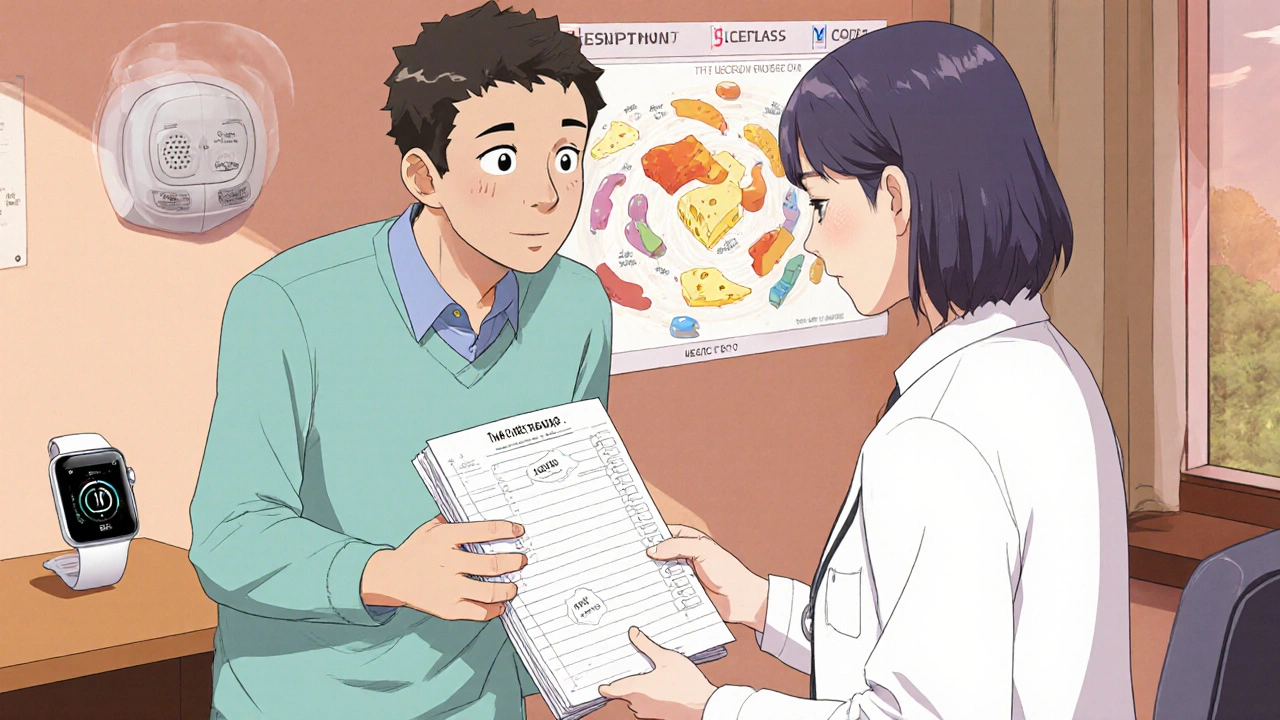Documenting Side Effects: How to Track Patterns and Triggers for Better Health
 Nov, 4 2025
Nov, 4 2025
Symptom Tracker & Pattern Identifier
Track Your Symptoms
Your Pattern Analysis
Recent Entries
Why Tracking Side Effects Changes Everything
If you’ve ever felt like your symptoms came out of nowhere-headaches, anxiety spikes, fatigue crashes-you’re not alone. The truth is, most side effects don’t just appear. They’re triggered. And if you don’t track them, you’re guessing. Documenting side effects isn’t about being obsessive. It’s about turning confusion into clarity. When you start writing down what happens, when it happens, and what was going on right before it, patterns emerge. Not guesses. Not hopes. Real, repeatable patterns.
People with migraines, chronic pain, anxiety, or reactions to medications have seen symptom frequency drop by 40-60% once they identify their triggers. That’s not magic. That’s data. And it’s accessible to anyone willing to spend five minutes a day.
The ABC Model: Your Simplest Starting Point
You don’t need a fancy app or a clinical degree to begin. The ABC model-Antecedent, Behavior, Consequence-is the most proven method used by behavior analysts, neurologists, and therapists. It’s simple:
- A (Antecedent): What happened right before the side effect? Were you stressed? Did you eat cheese? Did your phone buzz at 2 a.m.? Did you skip sleep?
- B (Behavior): What exactly happened? Not just “headache.” Write: “Throbbing pain behind left eye, rated 7/10, lasted 3 hours.”
- C (Consequence): What happened after? Did you take medication? Did you lie down? Did your mood improve or worsen?
Studies show that 87% of successful trigger identifications require at least 14 days of consistent ABC tracking. That’s two weeks. Not two months. Just 14 days of honest notes.
What to Track: The 7 Must-Record Details
Not all tracking is equal. Vague entries like “felt bad” or “had a flare” won’t help. You need specifics. Here’s what works:
- Date and time: Down to the 15-minute window. A headache at 10 p.m. is different from one at 4 a.m.
- Symptom intensity: Use a 0-10 scale. Zero is nothing. Ten is unbearable.
- Duration: How long did it last? 15 minutes? 8 hours?
- Medications and dosages: What did you take? When? Did you take it with food?
- Sleep: How many hours? Did you wake up often? Even 15 minutes of lost sleep can trigger a flare.
- Diet: What did you eat or drink in the 6-12 hours before? Caffeine? Alcohol? Processed meats? Cheese? These are top migraine triggers.
- Stress and environment: Rate stress 1-5. Was it noisy? Hot? Did you spend time in screens? Was there a fight? A deadline?
One user on Reddit tracked her migraines for 90 days and found 57% of her attacks followed eating aged cheese. That’s a life-changing insight-no more guessing about dinner.

Paper vs. Apps: Which One Actually Works?
There’s no one-size-fits-all tool. The best tracker is the one you’ll actually use.
Paper journals like MedShadow’s symptom tracker have a 91% compliance rate because they’re simple. No batteries. No updates. Just pen and paper. They’re especially effective for older adults-68% of users over 65 kept using them after six months, compared to just 39% for apps.
Digital apps like MigraineBuddy or Wave offer automation. Wave syncs with your Apple Watch to track heart rate and sleep. MigraineBuddy’s AI flags patterns you might miss. But here’s the catch: 43% of app users quit after 60 days because the interface is clunky. If you’re not tech-savvy, or you’re tired of notifications, paper wins.
Try this: Use paper for the first 30 days. Then, if you’re seeing patterns, switch to an app to save time. Don’t let tech make it harder.
How Long Until You See Results?
Most people expect instant answers. They don’t get them. Trigger identification takes time. But here’s what to expect:
- Days 1-7: You’ll feel like you’re recording everything for no reason. That’s normal.
- Days 8-14: You’ll start noticing repeats. “Every time I eat pizza, I get a headache.”
- Days 15-30: Patterns become clear. You’ll identify 1-3 major triggers.
- After 30 days: You’ll spend 22 minutes a week reviewing what you’ve written. That’s it.
Studies show that 74% of migraine patients identify at least one trigger within three months using a dedicated tool like MigraineBuddy. General trackers? Only 42% do. Specificity matters.
When Tracking Makes Things Worse
There’s a dark side. For 12-15% of people-especially those with anxiety disorders-tracking can spiral into obsession. You start checking your body every hour. You blame yourself for every symptom. You avoid food, people, or activities out of fear.
That’s not progress. That’s harm.
If you notice yourself:
- Checking your symptoms more than you live your life
- Feeling guilty when you don’t track
- Using tracking to avoid medical advice
Then pause. Talk to your doctor. Or a therapist. Tracking should give you control-not take it away.

How to Use This Data with Your Doctor
Most doctors don’t ask for this. But when you bring it, they listen.
Don’t say: “I think dairy makes me sick.” Say: “Over 30 days, I had 11 headaches. 9 of them happened within 6 hours of eating cheese or yogurt. I didn’t have headaches on days I avoided dairy. I’ve attached the log.”
That’s evidence. That’s power.
Hospitals like Mayo Clinic report that patients who bring detailed symptom logs reduce emergency visits by 37%. Why? Because you’re not describing a vague feeling-you’re showing a pattern. That changes treatment.
What’s Next: AI, Smart Homes, and the Future
The future of tracking is automatic. Apple Watch now detects subtle temperature changes that signal a migraine is coming 48 hours ahead. Smart thermostats can log if your room gets too dry. Fridges might soon track your food intake.
The NIH just funded $15.7 million to standardize tracking across 12 chronic conditions. The FDA cleared Twofold’s template for use in clinical trials. This isn’t a trend. It’s becoming standard care.
But here’s the truth: none of that matters if you don’t start now. The most powerful tool you have is your own attention. You don’t need AI to know that your headache always happens after coffee and no sleep. You just need to write it down.
Start Today: Your 5-Minute Action Plan
- Grab a notebook or open a notes app.
- Write today’s date.
- At bedtime, answer: What happened today that felt off? When? What was different?
- Rate intensity. Write the time. Note food, sleep, stress.
- Do this for 14 days. No exceptions.
You don’t need to be perfect. You just need to be consistent. The pattern will find you.

Lexi Brinkley
November 6, 2025 AT 15:01Edward Weaver
November 7, 2025 AT 07:43Erika Puhan
November 7, 2025 AT 17:15Kelsey Veg
November 9, 2025 AT 11:18Alex Harrison
November 9, 2025 AT 18:28Jay Wallace
November 11, 2025 AT 17:56Alyssa Fisher
November 13, 2025 AT 13:00Alyssa Salazar
November 13, 2025 AT 17:21Beth Banham
November 15, 2025 AT 16:48Brierly Davis
November 17, 2025 AT 03:27Amber O'Sullivan
November 17, 2025 AT 11:35Jim Oliver
November 17, 2025 AT 14:53William Priest
November 18, 2025 AT 12:25